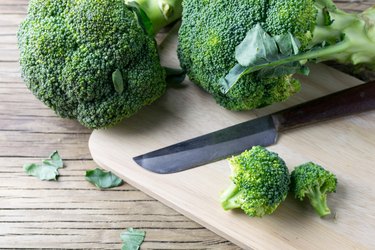
Broccoli's high vitamin content earns the vegetable "super-food" status. Thrifty cooks use as much of each broccoli bunch as possible, but if your own "bunch" consists of picky eaters who refuse to eat broccoli cuts, or stems, take heart. The stems and tops, also known as florets or flower heads, contain virtually the same nutrients -- although florets have more vitamin A. If your family demands a floret-only side dish, chop off broccoli stems with a clear conscience. Reserve stems for soup stock, stews and casseroles.
The Basics
Video of the Day
A 3.5 oz. serving of fresh florets or stems is a hearty one, equaling about 1 1/2 cups. The serving contains 28 calories, 3 grams protein and 5.2 grams carbohydrates. Neither broccoli part contains any saturated fat, and both parts take up only 1 percent of your daily allotment of sodium. Both stems and florets contribute about 10 percent of the dietary fiber you need each day.
Video of the Day
Vitamin A
Broccoli florets contain significantly more vitamin A than the stalks do. A 3.5 oz. serving of florets provides 60 percent of the vitamin A you need each day. The same amount of broccoli stems delivers only 8 percent of the daily value, or DV, for vitamin A, which promotes good eyesight, while also contributing to a healthy immune system.
Vitamin C
As a contributor of vitamin C, broccoli shines. Florets and stems each contribute about 150 percent of the vitamin C you need each day in each 3.5 oz. serving. Cooking diminishes vitamin C content slightly, but a cooked serving still delivers more than one day's worth of vitamin C, which helps strengthen your immune system. It also builds collagen, a substance responsible for healthy joints and skin.
Folate
Fresh broccoli stems and florets both contribute about 17 percent of the DV for folate in every 3.5 oz. serving. For that reason, the vegetable makes a good choice for pregnant women, who are urged to eat more of the B-complex vitamin. Getting enough folate helps lower the risk of birth defects.
Other Nutrients
Fresh broccoli florets and stems each contribute more than a day's worth of vitamin K, the nutrient that helps prevent excessive blood loss from injury, after surgery or during menstruation. Either broccoli part also delivers at least 5 percent of the DV for several B vitamins, as well as calcium, iron, potassium, phosphorus, magnesium and manganese.
Cooked Broccoli
For the most part, cooked broccoli is slightly higher in nutrients than an equal amount of fresh broccoli. The difference is partly to the vegetable's tendency to "cook down" and contribute more broccoli per serving. Vitamin C remains an exception to this rule because it dissipates with cooking. While both cooked and fresh broccoli are good sources of several vitamins and minerals, a significant increase occurs in vitamins A and K, folate and fiber when you cook broccoli stems or florets – especially in florets, which have more vitamin A than the stems. On the other hand, more vitamin C remains in fresh florets or stalks than in cooked broccoli. Frozen broccoli, especially florets, is high in vitamin A, but has more sodium and decreased quantities of vitamin C, iron and some B vitamins.